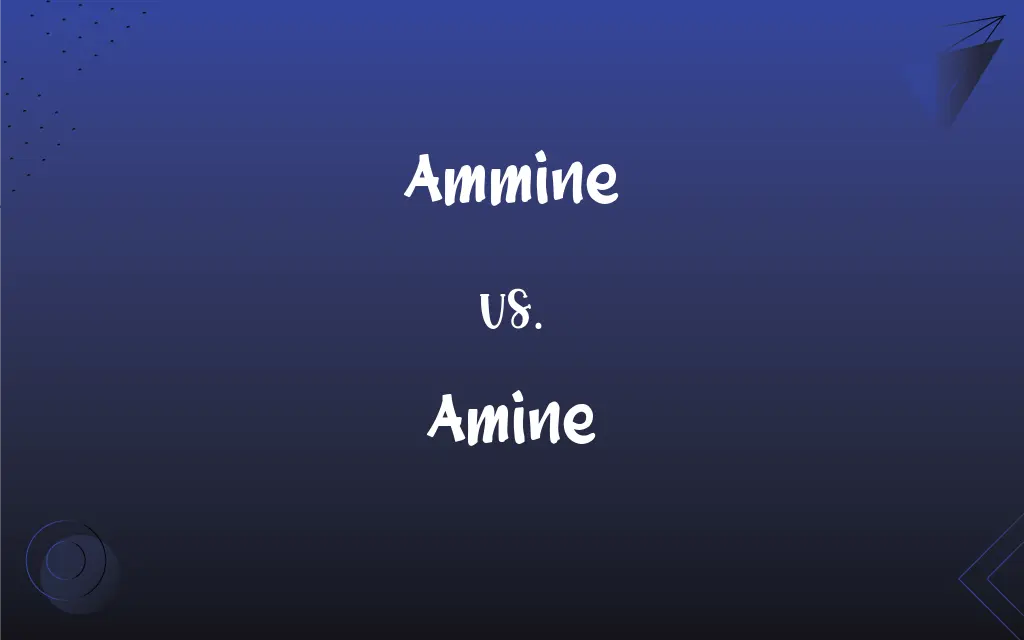Ammine vs. Amine: What's the Difference?
By Janet White & Harlon Moss || Updated on May 20, 2024
Ammine refers to a coordination complex where ammonia molecules are ligands bound to a central metal atom, while amine is an organic compound derived from ammonia, characterized by one or more alkyl or aryl groups replacing hydrogen atoms.

Key Differences
Ammine describes a coordination complex where ammonia molecules (NH₃) act as ligands, binding to a central metal ion. This term is commonly used in inorganic chemistry to describe metal-ammonia complexes, such as hexaamminecobalt(III) chloride, [Co(NH₃)₆]Cl₃. Amine, on the other hand, is an organic compound derived from ammonia (NH₃) by replacing one or more hydrogen atoms with alkyl or aryl groups. Amines are classified as primary (one alkyl/aryl group), secondary (two alkyl/aryl groups), or tertiary (three alkyl/aryl groups).
Ammine complexes involve metal-ligand bonding and are typically found in coordination chemistry. In contrast, amines are organic molecules with nitrogen-carbon bonds and are widely present in both natural and synthetic compounds.
Ammine is specific to complexes with ammonia as ligands, whereas amine refers to a broader category of nitrogen-containing organic compounds. The structures and applications of these compounds differ significantly, reflecting their distinct roles in chemistry.
Comparison Chart
Definition
Coordination complex with ammonia ligands
Organic compound derived from ammonia
Chemical Structure
Metal bound to ammonia molecules
Nitrogen atom bonded to alkyl/aryl groups
ADVERTISEMENT
Field of Study
Inorganic chemistry
Organic chemistry, biochemistry
Examples
Hexaamminecobalt(III) chloride, [Co(NH₃)₆]Cl₃
Methylamine (CH₃NH₂), aniline (C₆H₅NH₂)
Classification
Based on ligands (ammonia)
Primary, secondary, tertiary amines
Ammine and Amine Definitions
Ammine
Coordination complex with ammonia ligands.
[Co(NH₃)₆]Cl₃ is a well-known ammine complex.
Amine
Contains nitrogen bonded to alkyl/aryl groups.
Aniline (C₆H₅NH₂) is an aromatic amine.
ADVERTISEMENT
Ammine
Significant in inorganic chemistry.
Ammine complexes can exhibit unique colors and magnetic properties.
Amine
Organic compound derived from ammonia.
Methylamine (CH₃NH₂) is a simple amine.
Ammine
Involves metal-ligand interactions.
The stability of ammine complexes depends on the metal ion and its oxidation state.
Amine
Found in natural and synthetic compounds.
Amines are building blocks for proteins and pharmaceuticals.
Ammine
Metal ion bonded to NH₃ molecules.
Ammine complexes are often used in coordination chemistry studies.
Amine
Classified as primary, secondary, or tertiary.
Ethylamine (CH₃CH₂NH₂) is a primary amine.
Ammine
Example compound: Hexaamminecobalt(III) chloride.
[Co(NH₃)₆]Cl₃ is used to illustrate ligand field theory.
Amine
Crucial in organic chemistry and biochemistry.
Dopamine, a neurotransmitter, is an important biological amine.
Ammine
Any of a class of inorganic coordination compounds of ammonia and a metallic salt.
Amine
Any of a group of organic compounds of nitrogen, such as ethylamine, C2H5NH2, that may be considered ammonia derivatives in which one or more hydrogen atoms have been replaced by a hydrocarbon group.
Ammine
(inorganic chemistry) Any of a class of coordination compounds in which ammonia acts as a ligand.
Amine
(inorganic chemistry) A functional group formally derived from ammonia by replacing one, two or three hydrogen atoms with hydrocarbon or other radicals.
Ammine
A complex inorganic compound that contains ammonia molecules
Amine
(organic chemistry) Any organic compound containing an amine functional group.
Amine
One of a class of basic substances derived from ammonia by replacement of one or more hydrogen atoms by an alkyl or aryl group. Compare amide, in which an acyl group is attached to the nitrogen. Hydroxylamine and hydrazine, which are not an organic compounds, are also basic and may also be considered amines.
Amine
A compound derived from ammonia by replacing hydrogen atoms by univalent hydrocarbon radicals
FAQs
What is an ammine?
An ammine is a coordination complex where ammonia molecules are ligands bound to a central metal ion.
What fields study ammines and amines?
Ammines are studied in inorganic chemistry, while amines are studied in organic chemistry and biochemistry.
Can you give an example of an ammine complex?
Yes, [Co(NH₃)₆]Cl₃ (hexaamminecobalt(III) chloride) is a common example.
Can you give an example of an amine?
Yes, methylamine (CH₃NH₂) is a simple amine.
What is an amine?
An amine is an organic compound derived from ammonia by replacing hydrogen atoms with alkyl or aryl groups.
Are ammines found in organic chemistry?
No, ammines are primarily found in inorganic chemistry.
What is the role of ammonia in ammines?
Ammonia acts as a ligand that bonds to the central metal ion in ammine complexes.
How are ammines named?
Ammines are named based on the metal ion and the number of ammonia ligands, e.g., hexaamminecobalt(III) chloride.
What is the role of nitrogen in amines?
Nitrogen is the central atom in amines, bonded to alkyl or aryl groups.
Do ammines have significant industrial applications?
Yes, ammines are used in various industrial and chemical processes.
Can ammines be found in biological systems?
Ammines are generally not found in biological systems; they are more common in synthetic chemistry.
Can amines be found in biological systems?
Yes, amines are widely present in biological systems, such as amino acids and hormones.
Do amines have significant industrial applications?
Yes, amines are used in pharmaceuticals, agriculture, and chemical manufacturing.
How are ammines and amines different in terms of structure?
Ammines involve metal ions bonded to ammonia molecules, while amines have nitrogen bonded to carbon-containing groups.
Are amines important in biochemistry?
Yes, amines are crucial in biochemistry, being part of amino acids and neurotransmitters.
What determines the stability of an ammine complex?
The stability is influenced by the metal ion, its oxidation state, and the number of ammonia ligands.
What determines the classification of an amine?
Amines are classified based on the number of alkyl or aryl groups attached to the nitrogen atom.
Can ammines exhibit different colors?
Yes, ammines can exhibit various colors depending on the metal ion and its coordination environment.
How are amines named?
Amines are named based on the alkyl or aryl groups attached to the nitrogen, e.g., methylamine.
Can amines be aromatic?
Yes, aromatic amines, such as aniline, contain a benzene ring attached to the nitrogen atom.
About Author
Written by
Janet WhiteJanet White has been an esteemed writer and blogger for Difference Wiki. Holding a Master's degree in Science and Medical Journalism from the prestigious Boston University, she has consistently demonstrated her expertise and passion for her field. When she's not immersed in her work, Janet relishes her time exercising, delving into a good book, and cherishing moments with friends and family.
Co-written by
Harlon MossHarlon is a seasoned quality moderator and accomplished content writer for Difference Wiki. An alumnus of the prestigious University of California, he earned his degree in Computer Science. Leveraging his academic background, Harlon brings a meticulous and informed perspective to his work, ensuring content accuracy and excellence.































































